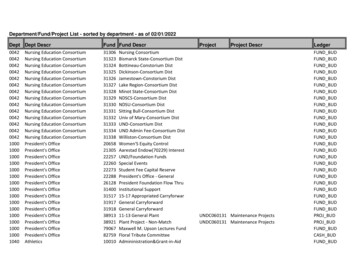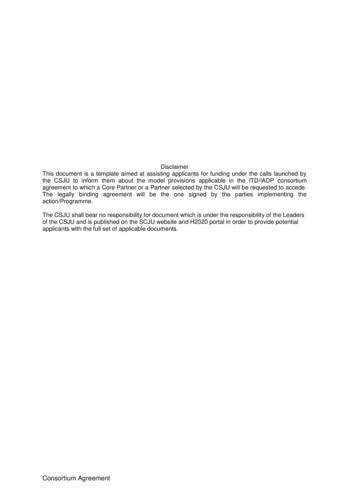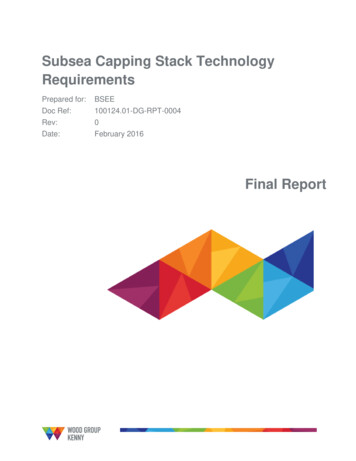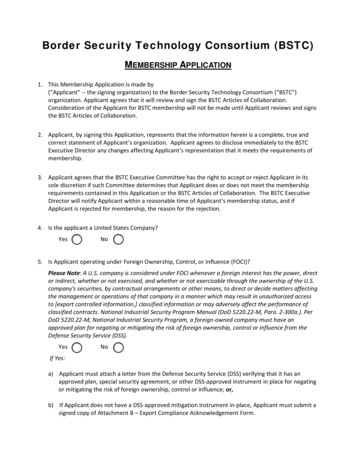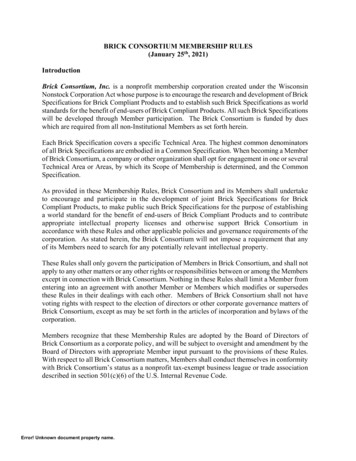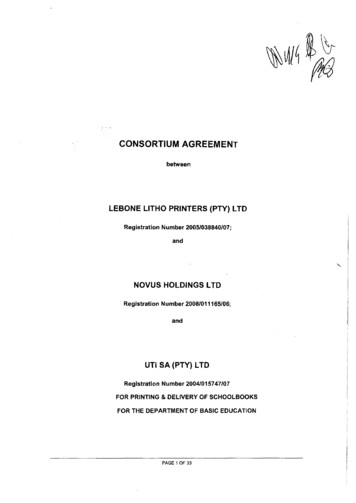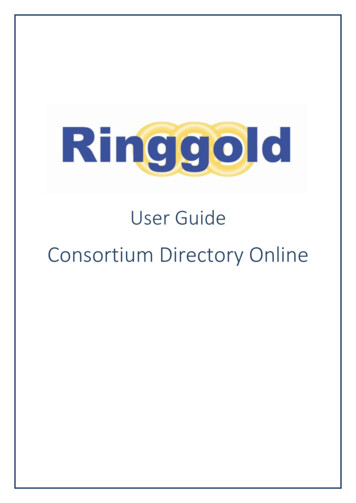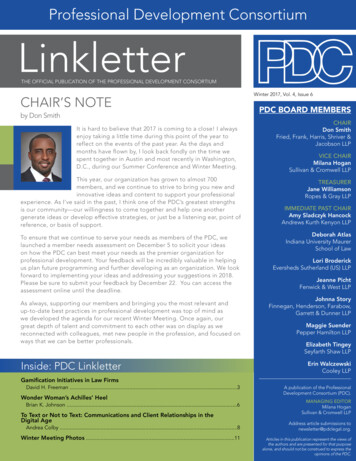
Transcription
Professional Development ConsortiumLinkletterTHE OFFICIAL PUBLICATION OF THE PROFESSIONAL DEVELOPMENT CONSORTIUMCHAIR’S NOTEby Don SmithWinter 2017, Vol. 4, Issue 6PDC BOARD MEMBERSCHAIRDon SmithFried, Frank, Harris, Shriver &Jacobson LLPIt is hard to believe that 2017 is coming to a close! I alwaysenjoy taking a little time during this point of the year toreflect on the events of the past year. As the days andmonths have flown by, I look back fondly on the time wespent together in Austin and most recently in Washington,D.C., during our Summer Conference and Winter Meeting.VICE CHAIRMilana HoganSullivan & Cromwell LLPThis year, our organization has grown to almost 700members, and we continue to strive to bring you new andinnovative ideas and content to support your professionalexperience. As I’ve said in the past, I think one of the PDC’s greatest strengthsis our community—our willingness to come together and help one anothergenerate ideas or develop effective strategies, or just be a listening ear, point ofreference, or basis of support.TREASURERJane WilliamsonRopes & Gray LLPIMMEDIATE PAST CHAIRAmy Sladczyk HancockAndrews Kurth Kenyon LLPDeborah AtlasIndiana University MaurerSchool of LawTo ensure that we continue to serve your needs as members of the PDC, welaunched a member needs assessment on December 5 to solicit your ideason how the PDC can best meet your needs as the premier organization forprofessional development. Your feedback will be incredibly valuable in helpingus plan future programming and further developing as an organization. We lookforward to implementing your ideas and addressing your suggestions in 2018.Please be sure to submit your feedback by December 22. You can access theassessment online until the deadline.Lori BroderickEversheds Sutherland (US) LLPJeanne PichtFenwick & West LLPJohnna StoryFinnegan, Henderson, Farabow,Garrett & Dunner LLPAs always, supporting our members and bringing you the most relevant andup-to-date best practices in professional development was top of mind aswe developed the agenda for our recent Winter Meeting. Once again, ourgreat depth of talent and commitment to each other was on display as wereconnected with colleagues, met new people in the profession, and focused onways that we can be better professionals.Maggie SuenderPepper Hamilton LLPElizabeth TingeySeyfarth Shaw LLPInside: PDC LinkletterGamification Initiatives in Law FirmsDavid H. Freeman .3Wonder Woman’s Achilles’ HeelBrian K. Johnson .6To Text or Not to Text: Communications and Client Relationships in theDigital AgeAndrea Colby .8Winter Meeting Photos .11 Erin WalczewskiCooley LLPA publication of the ProfessionalDevelopment Consortium (PDC).MANAGING EDITORMilana HoganSullivan & Cromwell LLPAddress article submissions tonewsletter@pdclegal.org.Articles in this publication represent the views ofthe authors and are presented for that purposealone, and should not be construed to express theopinions of the PDC.
CHAIR’S NOTE(Continued from Page 1)by Don SmithThis year, we spent a day focusing on staying relevant in a challenging legal industry. The meeting, titled“Disruptive Talent Management: Staying Visible in an Environment of Innovation,” kicked off with an interactiveicebreaker led by PDC board member Erin Walczweski. Longtime supporter and PDC advocate Terri Mottershead,principal at Mottershead Consulting, delivered the keynote, which flowed into an incredibly thought-provokingpanel (led by Werten Bellamy, president of Stakeholders Inc.) that provided key insights into the future of the legaldevelopment profession. Werten brought together a law firm managing partner, a general counsel, and learningand development professionals from both PwC and the Whirlpool Corporation, to give us their perspectives onhow we can best prepare ourselves, our attorneys, and our organizations to be competitive in the future.Following the panel, Mark A. Cohen, Esq., founder and CEO of Legal Mosaic, LLC, led us through a conversationon how technology is affecting PD professionals today and how it will affect us in the future. During lunch, PDCmembers Heather Bock and Michelle Nash from Hogan Lovells presented the 2017 Richard Pearson Award to theircolleague Lori Berman. We were thrilled to honor Lori as this year’s honoree. The day’s events concluded with adiscussion on maintaining our individual self-care and wellness goals to ensure that we maximize our performance,as well as a brainstorming session led by PDC members Jessie Spressart and Ceil O’Conner. Thank you to all whoattended.I look forward to seeing you in Portland, Oregon, July 19-21 for the 2018 Summer Conference. The RFP Processopened on December 7 and will close on January 26. Don’t just attend the Summer Conference—think aboutcoming and sharing some of your best ideas, insights, and experiences with your colleagues. Presenting is notonly a great way to add to the community, it’s a great professional development experience for you as well.I hope everyone had a productive and professionally fulfilling 2017. As you start setting new goals for 2018, I hopeyou keep the PDC and our community in mind as a resource for the year to come.Happy Holidays!Don SmithChair, Board of DirectorsWelcome to Our New Members!Please join us in recognizing the following PD professionals who became PDC members betweenSeptember 14, 2017, and December 14, 2017!Georgia Sussman, Feinstein LLPTania Abelowitz, Paul, Weiss, Rifkind, Wharton &Garrison LLPYakiry Adal, Stroock & Stroock & Lavan LLPDyana Barninger, K&L Gates LLPDonna Branca, Blank RomeJustin Evans, Chong KosterRebecca Gentry, WilmerHaleMyriah Graves, Fogler, Rubinoff LLPDenise Jaffe, Robinson Cole LLCTamesha Keel, Foley & LardnerLanette Matthews, Cooper & ScullyChristina Mitchell, Nixon Peabody LLPChelsey Parrott-Sheffer, Seyfarth Shaw LLPKurt Plocher, Winston & Strawn LLPJennifer Thomas, The Public Defender Service for theDistrict of ColumbiaColleen Tretola, Axinn, Veltrop & HarkriderLinda Vandercook, Shumaker, Loop & Kendrick LLPJulie Wood, Nixon Peabody LLP
GAMIFICATION INITIATIVES IN LAW FIRMSby David H. Freeman, J.D., Founder of Law Firm CultureShift David Freeman is a two-time best-selling author who has written four books on law firmleadership and business development. He has worked with nearly 200 law firms, hasrepeatedly been voted the top law firm business development coach and consultant in majornationwide surveys, is a PDC Trusted Advisor, and is a Fellow in the College of Law PracticeManagement. He can be reached at 949-715-0819 or David@LawFirmCultureShift.com.You’ve certainly had your fill of articles that open withsomething like “The legal industry is experiencingunprecedented change,” so let’s not bore you with thosegivens. One of your roles as experts in professionaldevelopment is to get people to change, so this isnothing new to you. What’s needed are fresh tools inyour PD toolbox to get more people engaged, acting inalignment with firm strategies.Planning is usually not the issue. According to the AltmanWeil 2016 Law Firms in Transition Survey, 83% of firmssurveyed engage in a formal strategic planning process.The bigger challenge is revealed in other data—only 8%of law firm leaders are highly confident in their firms'ability to keep pace with the challenges of the new legalmarketplace. So, even though most firms have plans,92% of firm leaders are not fully convinced they have theability to turn those plans into results.For leaders managing with an eye toward the future, fullyimplementing their plans becomes the golden ticket,the major differentiator from otherwise similar firms.With that in mind, the question becomes, what role canyou play to enhance your firm’s ability to implement yourplans?According to surveys of millions of workers conductedby the Gallup organization, the best way to improveperformance is to increase the engagement of theworkforce. For law firms, that means finding ways tofire up the troops, to develop approaches that can turnseemingly low-return, non-billable tasks into activitiesthey will enthusiastically embrace. As a leader, you’vebeen fighting this battle for a long time, so are theredifferent tactics you can employ to get people morefully engaged in achieving the firm’s strategic goals?PDC Linkletter Winter 2017Enter GamificationOne approach that is gaining significant traction inmanagement circles is the use of gamification. BrianBurke, a consultant with the Gartner Group and author ofGamify, simply defines gamification as “ the use of gamemechanics to engage and motivate people to achievetheir goals.” By tapping into people’s natural desires forcompetition and achievement, you can take somethingthat is potentially tedious and make it enjoyable.According to estimates from the Gartner Group, “40%of Global 1000 organizations will use gamification as theprimary mechanism to transform business operations (by2016)”. That’s worth repeating and emphasizing:“ theprimary mechanism to transform business operations.”Our corporate cousins are way ahead of our industrywhen it comes to running a business, so perhaps weshould take a page from their playbook by incorporatinga tool like gamification into our operations.How is gamification being used to teach, inspire,remind, and accelerate action? The following are severalexamples from other industries: SAP used it to increase employee engagement. Sun Microsystems used it for new hire onboarding. T-Mobile used it to create a collaborative communitydesigned to transform customer service. In Stockholm, the government used gamification todecrease speeding by fining those who sped andthen distributing the proceeds, via lottery, to thosewho did not speed in that area. AstraZeneca used it to teach their sales agents abouta new medicine.Page 3
GAMIFICATION INITIATIVES IN LAW FIRMS A 2,000-person consulting firm used it to helpemployees learn the names and faces of theircolleagues. Allstate used it to solicit innovative ideas from theiremployees. Hewlett Packard used it to achieve 1B in salesgrowth over a three-month period. Ford used it to help sales and service teamsbecome familiar with car models, financing plans,technologies, and options. Pep Boys used it to reduce retail loss and increasesafety for its 19,000 employees. Salesforce.com used it to raise awareness of theimportance of security. DirecTV used it to increase knowledge sharing,learning, and employee engagement. Lawley Insurance used a two-week contest to closemore sales than in the previous 7 months combined. Objective Logistics increased its profit margins40 percent using gamification.Now, many of you may be thinking, “My lawyers wouldnever play a game.” First, take a look around you.People are playing meaningless games on their phones,they log on to Facebook all day long, and they are highlyengaged (some might say addicted) to continue. Manyof those same people are your lawyers and staff, who arealready comfortable with gamified experiences. Morespecifically, based on surveys I conducted with law firmleaders, some firms have already successfully employedgamified approaches to drive desired behaviors. In onefirm, they were highly aware of one of the major obstaclesto such an initiative—the perception that there is littletime for something “extra.” According to Kate Tompkins,business development manager at Lathrop & Gage, “Wecreated the 'Take 10 Challenge,' which was ultimatelydesigned to negate the idea that business developmentand marketing have to be so time consuming andcomplicated. We wanted to get people excited aboutbusiness development and show them what they couldaccomplish if they could 'Take 10' minutes out of theirday or week to focus on networking and developing newrelationships.”To those of you who have “tried it here and it didn’twork,” often the culprit is the structure of the gamifiedprocess, not the concept itself. Just cobbling togethera program that has points, a leaderboard, and successbadges may not be enough. In fact, the GartnerGroup estimated that 80% of corporate gamificationefforts will fail because of poor design. It is well worththe effort to build it right the first time, because youmay not get a second chance if it crashes and burns.PDC Linkletter Winter 2017Design ElementsThere is a ton of science behind crafting an effectivegamified solution. For example, in addition to providingexternal motivators like points, badges, and physicalprizes (e.g., cash or swag), a well-designed approachmight incorporate elements like intrinsic rewards—elements that provide a sense of personal satisfaction.Daniel Pink, in his book Drive, points out that realchange occurs when efforts focus on activating internaldrivers like autonomy, mastery and purpose. In fact, trulycomprehensive programs take into account factors likegame dynamics, motivational psychology, behavioraleconomics, user experience, user interface, neurobiology,technology platforms and business systems in order tomaximize sustainable results.Using Gamification in a Law FirmYou are limited only by your imagination and businessneeds. You can gamify business development initiativeslike client service, cross-selling, team activity, conferenceparticipation, individual business development, leadership,writing blog posts or publishing alerts, alumni relations,and LinkedIn activity. Other examples identified in thesurveys include: Teaching substantive legal skills. Improving time entry. Innovating to identify emerging, overlooked, anduntapped possibilities for the firm. Increasing billable activity and engagement incollections. Supporting a local charity through an annual drive. An annual drive to support local charity.Whatever you choose to gamify, best practices suggeststarting small, running pilots, and working with thecoalition of the willing. Beginning with your early adopterswill allow you to gather data and collect successes thatcan serve as a springboard for wider adoption. Also,always learn from each experience and apply lessonslearned to the next iteration of your rollout.Once the rollout begins, realize you’re working within abell curve. Your top 20% will stay at the top and yourbottom 20% will do very little, so your best results willcome from your middle 60%. Focus on this population,and once the process is going, flip on your internal PRmachine to keep the momentum going. Lavish praise onthose who participate and make progress, and provideacknowledgement at group meetings, in internalpublications, and during one-on-one meetings. Youcan also stoke healthy competitive fires (individual andteam-based) by making results transparent. Accordingto Betsy Spellman, chief marketing officer at Steptoe &Johnson, “Tapping into lawyers' competitive instinctsPage 4
GAMIFICATION INITIATIVES IN LAW FIRMSworked well for us when we wanted to improve the qualityand read rate of client alerts. In this pilot project, wetracked their progress on a leader board so the resultswere transparent. We achieved significant improvementand provided praise and prizes to reward progress.We’ll definitely keep experimenting with gamification toachieve our goals.”ConclusionOrganizations worldwide are constantly looking forways to improve results, and gamification has becomea powerful new addition to their management toolbox.Creating a successful gamified program requires analysis,planning, and design, but once you figure it out, you cantap into a new source of energy, focus, and time thatcan be channeled toward achieving your most importantstrategic goals.Call for Trusted AdvisorsDo you know a consultant who will makea great PDC Trusted Advisor? We will besoliciting a “Call for TA’s” in the new year. Weencourage you to begin thinking about whowould be a valuable addition to this program.2018 PDC Summer ConferencePortland, OR - The Nines Hotel – July 19 - 21PDC Linkletter Winter 2017Page 5
WONDER WOMAN’S ACHILLES’ HEELby Brian K. JohnsonBrian K. Johnson has served as a communication consultant to the legal profession since1979. He teaches interpersonal communication skills to new attorneys, public speaking totransactional lawyers, and advocacy and persuasion to litigators. Every year he works one-onone with hundreds of attorneys and professional development administrators at Am Law 100law firms to help them improve their speaking skills.Whatever happened to Amy Cuddy’sclaims about power poses? ImagineWonder Woman or Superman withhands on hips, looking powerfuland confident, ready to take onany challenge. Cuddy said thatexpansive body postures causedpeople to feel more confident. Herpower poses had their Warholian 15minutes of fame just a few years ago.But utter the words “power pose” toan audience of law firm associates in2017, as I did recently, and instead ofnodding heads you get blank stares.At the 2016 PDC Summer Conferencein Naples, Florida, I had the pleasureof co-presenting a session called"Jump-StartYourLeadershipPresence" with Jodi Lucena-Pichardo.Power posing was still a hot topic atthis point. Cuddy’s TED Talk, "YourBody Language May Shape Who YouAre," had received over 30 millionviews, and her best-selling book,Presence: Bringing Your BoldestSelf to Your Biggest Challenges, hadbeen published in 29 languages.We eagerly incorporated Cuddy’ssuggestions into our presentation.We even projected a picture of Jodi’sadorable children power posing.How times have changed.As a PDC Trusted Advisor whoespoused Cuddy’s views to a PDCaudience, I want to explore thecontroversy that her flash-in-the-panideas provoked. In October 2017, TheNew York Times Sunday Magazinefeatured an article with the ominoustitle "When the Revolution Came forAmy Cuddy" that described how herpower pose research has been underattack by other researchers. Theytrashed her study’s small samplesize. Most especially, she was takento task for her claim that powerposing leads to a positive changein one’s hormones. Allegedly, folkswho do so experience an increasein testosterone, making them feelmore powerful, and a decrease in thestress hormone cortisol. Yet otherresearchers studying these effectscould not replicate those hormonalchanges.As a result of the attacks, Cuddy lefther tenure-track position at HarvardBusiness School last spring. She hasannounced that her next book willfocus on bullying, because that’swhat it felt like when the revolutioncame for her. The revolution that theTimes headline refers to has beentaking place in the social sciences,with dissidents complaining that vastamounts of social science researchare potentially bogus, deeply flawed,and cannot be replicated.But lest we feel too badly for Ms.Cuddy’s fate, she does have othercompensations, literally. If you searchonline, her current fee is 50,000 to 100,000 per speech. It doesn’t takemany speeches at that rate to surpassan annual academic salary, or arousea jealous vengeance in one’s fellowacademics who grab their pitchforksPDC Linkletter Winter 2017and man the barricades (and it was,of course, mostly men) of resistance.Her claims about hormones wereCuddy’s Achilles’ heel. But do youreally care about your hormonelevels if power posing makes you feelmore confident? I don’t. That washer central point. She responded bywriting the following:The key finding, the one that I wouldcall “the power posing effect,” issimple: adopting expansive posturescauses people to feel more powerful.Nine other studies in nine differentlabs, including one involving 200subjects, replicated that key finding.Power poses caused people to selfreport that they felt more powerful.After Cuddy’s TED talk, hundredsof people worldwide wrote toher telling her that power posingworked for them. Those power-posingenthusiasts weren’t concerned withtheir hormone levels. They felt morepowerful. Cuddy summed this upwhen she defended herself:I have confidence in the effects ofexpansive postures on people’sfeelings of power — and that feelingpowerful is a critical psychologicalvariable.As far as I’m concerned, such feelingsare the end of the argument forthose of us eager to be better publicspeakers. I’m not a research scientistconcerned with hormone levels. I’mPage 6
WONDER WOMAN’S ACHILLES’ HEELa communication skills coach strivingto help speakers feel more powerfuland comfortable. If you do, chancesare you will be more successful.Maybe the value of power posing issimply standing still and breathingcalmly for a couple minutes. Howoften in our busy lives do any of usdo that, especially as we’re revvingup to make a presentation?the topic is the benefits of petownership. The new study claimsthat petting a friendly dog or catreleases hormones that cause youto (wait for it!) feel good. Like weanimal lovers need a scientist to tellus that? Do you really care aboutwhat your hormones are up to whileyou are petting your beloved Fido orFifi?There is a timely postscript to thisdiscussion about hormones. As I putthe final touches on this article, yetanother news flash in the Sciencesection of The New York Timeslinks behavior and hormones. This timeIf, a year or so from now, the latestresearch debunks this claim aboutpets and hormones, would you stoppetting your dog or stroking yourcat? I hope not. The same goes forpower posing. If it is working for you,keep it up. And if you haven’t triedit yet, test the theory yourself. Readour blog post from 2016 for moredetails and give it a try before yournext big presentation or importantmeeting and see what effect it hasfor you.Blog Link: power-pose/ ]Write for the PDC BlogThe PDC is looking for its members to write for the Blog! If you are interested in contributing apersonal story, a summary of a recent/past training event, news about your firm, or anything relevantto our industry, please contact Kathy Bradley at kbradley@pdclegal.org or visit the PDC Link Blog pageat http://www.pdclegal.org/blog for further details!PDC Linkletter Winter 2017Page 7
TO TEXT OR NOT TO TEXT: COMMUNICATIONS ANDCLIENT RELATIONSHIPS IN THE DIGITAL AGEPLI Interview with Andrea ColbyAndrea L. Colby, Esq., principal of Pro Se, LLC, is an intellectual property attorney andcertified professional coach. She specializes in coaching, mentoring and consultingwith attorneys to help them find their voice—to express themselves and communicatemore effectively and efficiently with their clients, colleagues and opposing counsel. Herlegal career spanned the public, private and corporate sectors, including 28 years in theintellectual property department of Johnson & Johnson.In a series of interviews and articles, our 2017 VisionaryCorporate Partner, Practising Law Institute, bringsfour expert perspectives to our members. In this finalinterview, Andrea Colby, principal of Pro Se, LLC—Coaching for Lawyers, speaks with PLI Legal EditorPaul Matsumoto and shares some of her insights aboutbuilding and maintaining client relationships — andspecifically the challenges that digital communicationspresent for attorneys.PLI: I think everyone would agree that communicationskills are critical for all attorneys in establishing andbuilding client relationships.ANDREA: Absolutely. Consider the specific skills thatwe as attorneys have had to build. These include writtenadvocacy as well as the ability to converse and discusslive, in a concise and eloquent way, whether by phone orin person. You also need to be able to project empathyfor your client. Getting to know your client personallyand conducting regular live meetings are also skills thatare good to have. Ultimately we need to be able to tellour clients’ stories, in writing or verbally—that’s whatthey hire us for. But we also need to be able to relate toand get to know our clients as people so that they alsoget to know us. In this way, they’ll come to trust us andtrust us to be able to tell their story.PLI: How is this any different today as compared to 15 oreven 10 years ago?ANDREA: In a word, technology. Technology isconstantly introducing new and more sophisticatedways for us to communicate with our clients.Thanks to the recent, rapid developments in digitaltechnology—texts, instant messaging, social media—wehave unprecedented access to thousands of people ina split second, without having to dial the phone, visitthem, or even talk to them directly.PDC Linkletter Winter 2017PLI: It’s not your grandparents’ workplace—it’s not evenyour parents’ workplace!ANDREA: That’s right. Today is the world of what wecall “mediated communications,” which we need todistinguish from “direct communications.” We refer todigital communications such as texts, instant messages,and social media as “mediated,” and live communicationsas “direct.” One of today’s challenges is to adapt andintegrate these new styles of communicating in theappropriate ways in order to build our client relationshipsand keep our clients coming back to us.PLI: But what difference does it make which mode ofcommunication we choose? We’re getting our pointacross one way or the other.ANDREA: Let’s consider how we react when we get anemail, for example, as opposed to receiving a text onour phone. An email we can answer when we get toit. We can consider what we’re going to say and howwe’re going to respond, and it gives us some time to dothat. Getting a text is a whole different matter, becausethere’s an immediacy about it. And we tend to infer fromreceiving it that we must answer it instantaneously. It’sanalogous to, when I was growing up, expecting a longdistance phone call. The phone would ring and everyonewould say, “It’s Aunt Mary! It’s long distance—we have toanswer the phone!” It’s almost a limbic system response:we have to answer. But these days, when we get a text,we may not give sufficient thought to our responses.And that can be problematic.PLI: How so?ANDREA: In this increasingly litigious time, we mustconsider that not only do we communicate all the time inmany different ways, but much of what we communicate,especially texts, email, and social media posts, ispreserved for posterity—whether we intend it to be ornot. So we need to be careful about how we respond. Thechallenge is to preserve our equanimity and judgmentPage 8
TO TEXT OR NOT TO TEXT: COMMUNICATIONS AND CLIENT RELATIONSHIPS IN THE DIGITAL AGEwhen we receive instantaneous, seemingly urgentcommunications. When we’re dealing with clients, weneed to convey a well-mediated, calm demeanor. That’swhat they’re looking for us to convey to them.PLI: What other challenges do we face in this digital agebeyond specific technologies?ANDREA: Another big factor is the composition of ourworkforce. Think about this: more than one-third oftoday’s total workforce has never functioned in a workenvironment in which email did not exist.PLI: You’re talking about “Millennials.”ANDREA: Yes. Right now, we have four generationsin our workforce. Data shows that Millennials—adultsborn in 1982 or later—now represent the largest shareof U.S. workers—almost 35%. They recently surpassed“Generation X”—those people born between about 1965and 1981. The other two generations in our workforceare “Baby Boomers”—folks born after about 1945—andthen what many call the “Silent Generation”—peopleborn before 1945 and who today represent just a littlemore than 2% of the U.S. workforce. It’s also importantto note that if one-third of our workforce is made up ofMillennials, it follows that one-third of our clients andpotential clients are Millennials as well.PLI: But why is this distinction important? We’ve alwayshad three or four generations in our workforce at anygiven time.ANDREA: Think about the implications for communicationin a workplace where one out of every three of yourcolleagues was born after 1982. These are the individualswho ask those of us from the other generations, “Whatdid you ever do without cellphones?” But if Millennialsrepresent one-third of the workforce, this means thattwo-thirds of the workforce are non-Millennials—theSilent Generation, Baby Boomers, and Gen X’er cohorts.We’re talking about individuals born before 1982, wholearned to develop relationships with clients and othersbefore we had these kinds of mediated communications.Not only did they learn the skills to communicate in adirect way, whether by phone or live and in person, butthey’ve had to learn new technologies as those havebeen introduced over the decades—whether it’s cables,voicemail, faxes, email, text messages, or social media.Contrast this with Millennials, who are typicallywell skilled in mediated communications and arecomfortable using these technologies, but who arenot accustomed to adding to their arsenal of skills ineffective communication, particularly when it comesto developing direct communications skills. In fact,Millennials are often so uncomfortable with face-to-face,verbal, live communications that they have a propensityto avoid them.PDC Linkletter Winter 2017PLI: Can you give some examples of this?ANDREA: Sure. I’ve heard many parents complain thatwhen the telephone rings at home, nobody gets up toanswer it. I also recall a recent Wall Street Journal articlethat reported a similar phenomenon—that when thedoorbell rings at home, nobody answers it anymore. TheMillennial view is that if friends are coming over, they’lltext you first. So if the doorbell rings, it’s someone youdon’t know. Or just ask a young colleague: “When’s thelast time you made dinner reservations on the phone?”PLI: You’re right. Today almost everything can be doneonline, without ever speaking with a person.ANDREA: We can, though, use direct
THE OFFICIAL PUBLICATION OF THE PROFESSIONAL DEVELOPMENT CONSORTIUM Professional Development Consortium Winter 2017, Vol. 4, Issue 6 CHAIR'S NOTE by Don Smith It is hard to believe that 2017 is coming to a close! I always enjoy taking a little time during this point of the year to reflect on the events of the past year. As the days and
